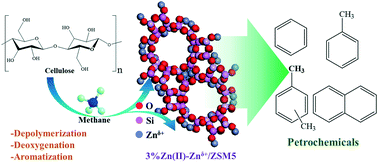当前位置:
X-MOL 学术
›
Catal. Sci. Technol.
›
论文详情
Our official English website, www.x-mol.net, welcomes your
feedback! (Note: you will need to create a separate account there.)
Direct catalytic co-conversion of cellulose and methane to renewable petrochemicals†
Catalysis Science & Technology ( IF 4.4 ) Pub Date : 2018-10-01 00:00:00 , DOI: 10.1039/c8cy01749b Aiguo Wang 1, 2, 3, 4 , Danielle Austin 1, 2, 3, 4 , Peng He 1, 2, 3, 4 , Xiaohui Mao 4, 5, 6, 7 , Hongbo Zeng 4, 5, 6, 7 , Hua Song 1, 2, 3, 4
Catalysis Science & Technology ( IF 4.4 ) Pub Date : 2018-10-01 00:00:00 , DOI: 10.1039/c8cy01749b Aiguo Wang 1, 2, 3, 4 , Danielle Austin 1, 2, 3, 4 , Peng He 1, 2, 3, 4 , Xiaohui Mao 4, 5, 6, 7 , Hongbo Zeng 4, 5, 6, 7 , Hua Song 1, 2, 3, 4
Affiliation

|
The catalytic co-conversion of cellulose and methane to aromatics was investigated over various Zn-containing zeolite catalysts. Higher aromatic yield (42.3% C) with BTEX selectivity of 70% and much lower solid residue yield (char: 9.45% C) are achieved over 3%Zn(II)–Znδ+/ZSM5 (0 < δ < 2) at 450 °C and 2.5 MPa. The loading of ZnO clusters or Zn2+ ions could be beneficial for the formation of aromatic products, and the introduction of Znδ+ species via CVD could improve BTEX selectivity and methane conversion. Co-feeding with methane inhibits the formation of coke or heavy substances and maximizes the carbon utilization efficiency for the formation of aromatics. Methane also enhances the oxygen removal efficiency to improve the quality of the liquid products. Methane participation in the formation of aromatic products is evidenced by liquid 1H, 2H and 13C NMR investigations, which reveal that methane tends to be incorporated into both the methyl group and the phenyl ring. The results of pyridine absorption and NH3-TPD indicate that the balanced distribution of Brønsted and Lewis acid sites and the appropriate ratio of weak to moderate acidic sites may benefit aromatic formation. XPS and XAS spectra of Zn species confirm the presence of Znδ+ species with oxygen vacancies, which show a higher selectivity for petrochemicals. The results reported in this work will give more insight into the catalytic chemistry of cellulose valorization under a methane environment and the design of rational catalysts for the cost-efficient utilization of biomass resources and natural gas.
中文翻译:

纤维素和甲烷直接催化共转化为可再生石化产品†
在各种含锌沸石催化剂上研究了纤维素和甲烷催化共转化为芳烃。更高的芳族产率(42.3%C)以70%的选择性BTEX和低得多的固体残余物的产率(炭:9.45%C)的超过达到3%的Zn(II)-Zn δ + / ZSM5(0 < δ <2)在450°C和2.5 MPa。ZnO团簇或Zn 2+离子的负载可能有利于芳香族产物的形成,以及通过Znδ +物种的引入。CVD可以提高BTEX选择性和甲烷转化率。与甲烷共同进料可抑制焦炭或重物质的形成,并最大程度地提高了碳的利用效率,从而形成了芳烃。甲烷还提高了除氧效率,从而改善了液体产品的质量。液体1 H,2 H和13 C NMR研究证明了甲烷参与芳香族产物的形成,这表明甲烷倾向于同时结合到甲基和苯环中。吡啶吸收和NH 3的结果-TPD表明布朗斯台德和路易斯酸位点的平衡分布以及弱酸位与中度酸位的适当比例可能有利于芳香族的形成。锌物种的XPS和XAS光谱证实存在具有氧空位的Znδ +物种,这表明其对石化产品的选择性更高。这项工作中报告的结果将使人们对甲烷环境下纤维素增值的催化化学有更多的了解,并为合理利用生物质资源和天然气而设计合理的催化剂。
更新日期:2018-10-01
中文翻译:

纤维素和甲烷直接催化共转化为可再生石化产品†
在各种含锌沸石催化剂上研究了纤维素和甲烷催化共转化为芳烃。更高的芳族产率(42.3%C)以70%的选择性BTEX和低得多的固体残余物的产率(炭:9.45%C)的超过达到3%的Zn(II)-Zn δ + / ZSM5(0 < δ <2)在450°C和2.5 MPa。ZnO团簇或Zn 2+离子的负载可能有利于芳香族产物的形成,以及通过Znδ +物种的引入。CVD可以提高BTEX选择性和甲烷转化率。与甲烷共同进料可抑制焦炭或重物质的形成,并最大程度地提高了碳的利用效率,从而形成了芳烃。甲烷还提高了除氧效率,从而改善了液体产品的质量。液体1 H,2 H和13 C NMR研究证明了甲烷参与芳香族产物的形成,这表明甲烷倾向于同时结合到甲基和苯环中。吡啶吸收和NH 3的结果-TPD表明布朗斯台德和路易斯酸位点的平衡分布以及弱酸位与中度酸位的适当比例可能有利于芳香族的形成。锌物种的XPS和XAS光谱证实存在具有氧空位的Znδ +物种,这表明其对石化产品的选择性更高。这项工作中报告的结果将使人们对甲烷环境下纤维素增值的催化化学有更多的了解,并为合理利用生物质资源和天然气而设计合理的催化剂。











































 京公网安备 11010802027423号
京公网安备 11010802027423号